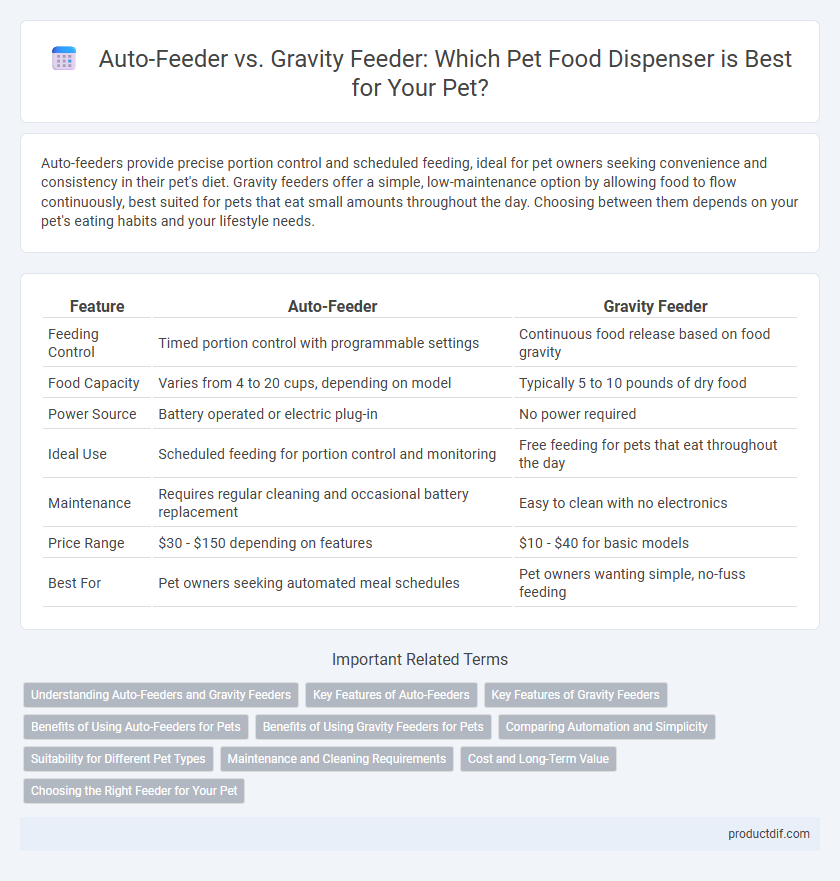Auto-feeders provide precise portion control and scheduled feeding, ideal for pet owners seeking convenience and consistency in their pet's diet. Gravity feeders offer a simple, low-maintenance option by allowing food to flow continuously, best suited for pets that eat small amounts throughout the day. Choosing between them depends on your pet's eating habits and your lifestyle needs.
Table of Comparison
| Feature | Auto-Feeder | Gravity Feeder |
|---|---|---|
| Feeding Control | Timed portion control with programmable settings | Continuous food release based on food gravity |
| Food Capacity | Varies from 4 to 20 cups, depending on model | Typically 5 to 10 pounds of dry food |
| Power Source | Battery operated or electric plug-in | No power required |
| Ideal Use | Scheduled feeding for portion control and monitoring | Free feeding for pets that eat throughout the day |
| Maintenance | Requires regular cleaning and occasional battery replacement | Easy to clean with no electronics |
| Price Range | $30 - $150 depending on features | $10 - $40 for basic models |
| Best For | Pet owners seeking automated meal schedules | Pet owners wanting simple, no-fuss feeding |
Understanding Auto-Feeders and Gravity Feeders
Auto-feeders offer controlled, programmable meal portions ideal for pet health management, using electronic timers or sensors to dispense food at set intervals. Gravity feeders provide a simple, continuous food supply through a gravity-fed hopper, enabling pets to eat at their own pace but with less portion control. Choosing between auto-feeders and gravity feeders depends on pet dietary needs, feeding schedules, and owner convenience preferences.
Key Features of Auto-Feeders
Auto-feeders provide precise portion control and customizable feeding schedules, ensuring pets receive the right amount of food at consistent times. These devices often include programmable timers, digital displays, and sometimes connectivity to smartphone apps for remote feeding management. Unlike gravity feeders, auto-feeders prevent food overeating and maintain freshness by dispensing food only when scheduled.
Key Features of Gravity Feeders
Gravity feeders rely on a simple design that uses gravity to dispense pet food continuously as the food level decreases, eliminating the need for batteries or electric power. Their key features include a large storage capacity, easy refilling, and maintenance-free operation, making them ideal for pet owners seeking convenience and reliability. Gravity feeders are also suitable for pets that eat free-choice rather than scheduled meals, ensuring consistent food availability throughout the day.
Benefits of Using Auto-Feeders for Pets
Auto-feeders provide precise portion control and customizable feeding schedules, ensuring pets receive the right amount of food at consistent times, which supports better weight management and overall health. These feeders reduce the risk of overfeeding and help maintain a regular routine, especially beneficial for pet owners with busy lifestyles or multiple pets. Unlike gravity feeders that rely on pet access to free-feed, auto-feeders automate meal distribution, minimizing food waste and promoting disciplined eating habits.
Benefits of Using Gravity Feeders for Pets
Gravity feeders provide a consistent food supply by automatically replenishing pet food as it is consumed, reducing the risk of missed meals. These feeders require minimal maintenance and electricity, making them cost-effective and reliable for pet owners. Their simple design accommodates various pet sizes and food types, promoting steady eating habits and reducing food waste.
Comparing Automation and Simplicity
Auto-feeders offer precise portion control and programmable feeding schedules for consistent pet nutrition, making them ideal for busy pet owners seeking automation. Gravity feeders provide a simple, no-power, refill-when-empty solution that relies on gravity to dispense food, suitable for pet owners valuing ease of use and low maintenance. Choosing between automation and simplicity depends on your pet's feeding needs and your lifestyle preferences.
Suitability for Different Pet Types
Auto-feeders offer precise portion control and scheduled meal times, making them ideal for pets with specific dietary needs or those prone to overeating. Gravity feeders provide a continuous food supply, suitable for pets that graze throughout the day or have irregular eating habits. Small pets like cats and small breeds benefit from auto-feeders, while larger dogs often thrive with gravity feeders due to their higher food intake.
Maintenance and Cleaning Requirements
Auto-feeders require regular battery checks and electronic component cleaning to ensure proper functioning, while gravity feeders have minimal maintenance with occasional refilling and simple wiping. Auto-feeders need thorough cleaning to prevent food buildup in the mechanical parts, whereas gravity feeders typically only require surface cleaning to maintain hygiene. Choosing between the two depends on how much effort one is willing to invest in routine maintenance and cleaning frequency.
Cost and Long-Term Value
Auto-feeders generally have a higher initial cost compared to gravity feeders but offer programmable feeding schedules that reduce food waste and ensure consistent portion control. Gravity feeders are more affordable upfront and require minimal maintenance, making them cost-effective for budget-conscious pet owners. Over the long term, auto-feeders provide better value through precise feeding management, while gravity feeders may incur additional expenses from overfeeding and frequent refills.
Choosing the Right Feeder for Your Pet
An auto-feeder provides precise portion control and scheduled feeding times, ideal for pets needing consistent meal frequency or weight management. Gravity feeders offer a more affordable, low-maintenance option by allowing food to flow freely into the bowl, suitable for pets that can self-regulate their eating. Selecting the right feeder depends on your pet's eating habits, portion control needs, and your lifestyle preferences.
Auto-feeder vs Gravity Feeder Infographic

 productdif.com
productdif.com